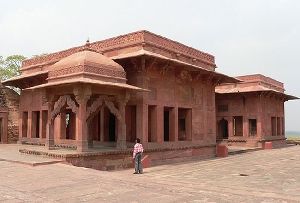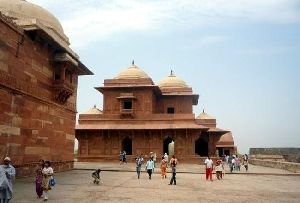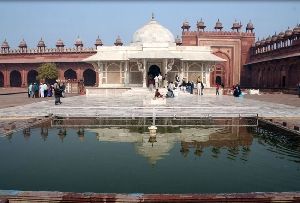Fatehpur Sikri Travel Guide
When it comes to the best places to visit in Agra, Fatehpur Sikri is one of the places that comes to mind. A town located in the Agra District of Uttar Pradesh, founded in 1571 by Mughal Emperor Akbar, the city holds a significant position in Indian history. This ancient town in Agra holds its position in the list of UNESCO World Heritage Sites and one of the best tourist attractions in Agra. A visit to Fatehpur Sikri allows you to witness its architectural marvel and to learn about its glorious past.
The city was recognized as Fatehpur Sikri, also known as the “City of Victory”, after Akbar’s unbeaten Gujarat campaign in 1573. The name of the city is taken from the village called Sikri, which occupied the area before. After an excavation, which was done by the Archaeological Survey of India (ASI) between 1999 to 2000 indicated that there was a habitation, temples, and commercial centers here before Akbar built his capital. A trip to Fatehpur Sikri along with an encounter of the popular historic sites is a must-do for experience addicts!
History of Fatehpur Sikri
It is said that Akbar desires to have children, so he and his wife Jodha Bai planned a visit to the Dargah of Khwaja Moinuddin Chishti, which is located in Ajmer. While reaching Ajmer, en-route, Akbar met a Sufi Saint, Sheikh Salim Chishti at a place called Sikri. After meeting the saint Akbar expressed his desires, then Sheikh Salim Chishti predicted the birth of his heir, and when the prediction was fulfilled, he asked Akbar to arrange his stay at the place and Akbar commenced constructing his capital in the village. It took almost 15 years to establish the town. After the completion of the construction, a new town Fatehpur Sikri was established in 1559 AD.
Fatehpur Sikri served as the capital of the Mughal Empire from 1571 AD to 1585 AD. In 1573, when Akbar returned victorious from his Gujarat campaign, the city was named Fatehpur Sikri or the City of Victory to celebrate the win. Late in 1585, Akabar abandoned the city as he moved towards Punjab for his next military campaign. According to historians, the city was abandoned due to two basic reasons – the shortage of water and the crisis in the north-western part of the country. Akbar later shifted the capital of his empire to Lahore and then to Agra, and by 1610 due to which Fatehpur Sikri became completely abandoned. A few years later, when the colonial rulers captured Agra in 1803, they set up an administrative center here, which remained operative till 1850. The monuments at Fatehpur Sikri were restored in 1815 under the orders of the Marquess of Hastings.
Checkout: Agra Tour Packages, Lucknow Tour Packages, Mathura Tour Packages, Uttar Pradesh Tour Packages, Jhansi Tour Packages, Varanasi Tour Packages
Uniqueness in Architecture
Taking about its architecture then the town is surrounded by 6 km long defensive walls having various entryways on three sides while the fourth side borders on an artificial lake. The city is dotted with palaces, mosques, tombs, public buildings, and other monuments. The constructions all together using red sandstone boast an Indo-Islamic style of architecture.
This fortified city has three palaces, which were built by Akbar for his three beloved wives. The eight gates built in the city serve as an entrance which includes Delhi Gate, the Agra Gate, the Lal Gate, The Gwalior Gate, and the Ajmeri Gate, amongst others. From one of the largest functional mosques in India, Jama Masjid to complex architectural marvels like Buland Darwaza the town is endowed with some of the most exquisite constructions to cherish.
Major Attractions to Explore in Fatehpur Sikri Jama Masjid
Known as one of India’s largest functional mosques, holding its position on the list of world heritage sites by UNESCO. Jama Masjid was built by the Mughal emperor Akbar between 1571-72 AD. The mosque was designed and built under the guidance of Sufi Saint Sheikh Salim Chishti. The mosque is also noted as the Friday Mosque. Talking about its architecture then, it boasts about a rectangular construction with a broad courtyard having three entries from the North, South, and East. The interiors are beautifully decorated with shiny tiles, ornate stones, and portraits carved with the Holy Quran.
Buland Darwaza
The Buland Darwaza is the main entrance to enter the Jama Masjid, Fatehpur Sikri, and also referred to as the Gate of Magnificence. It was built by emperor Akbar in 1576 AD after the prosperous victory over Gujarat. This giant construction is made with red sandstone and adorned with black and white marble. The Buland Darwaza is 54m tall, which is a beauty to behold.
Archaeological Museum
Witness the pre-Mughal and Mughal artifacts, which were founded in the city – Fatehpur Sikri. The galleries of the museum showcase the monolithic stone tools of the pre-historic era. It also depicts Jain sculptures, small stone sculptures, and figurines. The Archaeological Museum was completely ruined before the work of restoration between 2002-2004.
The Birbal’s Palace
An excellent representation of Mughal architecture and the official residence of the main commander of the army of the Mughal emperor, Birbal. This beautiful palace was built around 1571 AD. The Birbal’s Palace was once a part of the Royal Zenana, where queen Ruqayya Begum and Salima Begum stayed. The place has a beautiful interior as well as exterior, adorned with elaborate carvings.
Hiran Minar
The Mughal Emperor, Akbar built this beautiful masterpiece. According to legend it was built in remembrance of his beloved elephant, Hiran. It is also said that this tower is embedded with elephant tusks. It is also said that Akbar sat atop the Minar to watch elephant fights. According to another anecdote, it was the place where Akbar used to watch polo matches, which was played beside a lake. Now this tower stands abandoned between the Elephant Gate and the barren lake, which is now turned into fields. Taking its architecture, the Minar has an octagonal shape standing with a height of 21.34 meters.
Panch Mahal
The Panch Mahal is one of the iconic castles to witness in Fatehpur Sikri. It is another beautiful representation of Mughal architecture. Panch Mahal is also known as a wind tower and is made of red sandstone. Talking about its architecture then the Mahal has a five-story structure, having five pavilions adjoined by the staircases. The pillars of the Mahal have exquisite carvings of Persian, Hindu, and Jain elements. It remained an ideal summer getaway for the royal family.
Palace of Jodha Bai
The palace is one of the most comprehensive and significant constructions in the town. It was built for Akbar’s Rajput wife, Jodha Bai, who was known for her beauty. Taking about its construction then the palace has huge walls and a 9 meters tall gate. The Palace of Jodha Bai boasts of Hindu elements and Islamic styles in the structure. The palace is located next to the Hawa Mahal and the Mughal Charbagh-style garden.
Timing and Ticketing
The city remains open on all days of the week. Except for Friday, for some of the tourist attractions. Scroll down to know about the visiting hours and ticket cost for places to visit in Fatehpur Sikri.
Jama Masjid
- Timings: 6:00 am – 6:00 pm
- Ticketing: INR 20 (Indians), INR 260 (Foreigners)
Buland Darwaza
- Timings: 7:00 am – 6:00 pm
- Ticketing: INR 20 (Indians), INR 260 (Foreigners)
Archaeological Museum
- Timings: 9:00 am – 5:00 pm
- Ticketing: Free
Birbal’s Palace
- Timings: 7:00 am – 6:00 pm, Closed on Friday
- Ticketing: INR 20 (Indians), INR 260 (Foreigners)
Hiran Minar
- Timings: 7:00 am – 6:00 pm
- Ticketing: INR 20 (Indians), INR 260 (Foreigners)
Jodha Bai Palace
- Timings: 7:00 am – 6:00 pm, Closed on Friday
- Ticketing: INR 20 (Indians), INR 260 (Foreigners)
Panch Mahal
- Timings: 7:00 am – 6:00 pm
- Ticketing: INR 20 (Indians), INR 260 (Foreigners)
Interesting Facts about Fatehpur Sikri
- Fatehpur Sikri is an Arabic name, Fateh means “Victory” and Sikri means “thanks to God”.
- Fatehpur Sikri is the first planned city in India, which was established by the Mughals.
- The construction of Old Delhi is inspired by the structure and layout of Fatehpur Sikri.
- The Mughal Emperor Akarb only visited Fatehpur Sikri for once before his death after he completely abandoned the city.
- It is said that Akbar’s son Jahangir resided at Fatehpur Sikri for three months in 1619 during the bubonic plague.
- The Buland Darwaza is the highest gateway in the world.
How to Reach Fatehpur Sikri
Fatehpur Sikri is located about 40 kilometers away from Agra city. One can easily reach this town on arrival at Agra. Scroll down to more details about how to reach Fatehpur Sikri from Agra.
By Air: The nearest airport to Fatehpur Sikri is the Kheria Airport, which is about 34 km away from the town. You can hire a taxi at the airport to reach Fatehpur Sikri.
By Rail: The nearest railway station to Fatehpur Sikri is The Agra Cantt Railway Station, which is about 37 km away from the Fatehpur Sikri. On arrival, you can hire a taxi to reach the town.
By Road: To reach Fatehpur Sikri by road is not a tough job. The UPSRTC bus service provides easy connectivity to Fatehpur Sikri from Agra and the other major cities in Uttar Pradesh. These buses charge a very minimum cost and are easily available.











